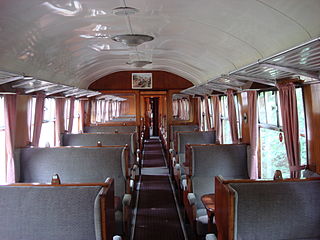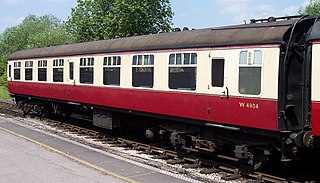
The Snowdon Mountain Railway is a narrow gauge rack and pinion mountain railway in Gwynedd, north-west Wales. It is a tourist railway that travels for 4.7 miles (7.6 km) from Llanberis to the summit of Snowdon, the highest peak in Wales.

The Tanfield Railway is a 4 ft 8+1⁄2 instandard gauge heritage railway in Gateshead and County Durham, England. Running on part of a former horse-drawn colliery wooden waggonway, later rope & horse, lastly rope & loco railway. It operates preserved industrial steam locomotives. The railway operates a passenger service every Sunday, plus other days, as well as occasional demonstration coal, goods and mixed trains. The line runs 3 miles (4.8 km) between a southern terminus at East Tanfield, Durham, to a northern terminus at Sunniside, Gateshead. Another station, Andrews House, is situated near the Marley Hill engine shed. A halt also serves the historic site of the Causey Arch. The railway claims it is "the world's oldest railway" because it runs on a section dating from 1725, other parts being in use since 1621.

The Avon Valley Railway (AVR) is a standard gauge heritage railway in South Gloucestershire, England, operated by a local group, the Avon Valley Railway Company Ltd. The 3-mile (5 km) heritage line runs from Oldland Common to Avon Riverside. It follows the Avon Valley southeast from Oldland Common to Bitton and then it runs alongside the River Avon from Bitton towards Saltford.
British Railways coach designations were a series of letter-codes used to identify different types of coaches, both passenger carrying and non-passenger carrying stock (NPCS). The code was generally painted on the end of the coach but non-gangwayed stock had the code painted on the side. They have been superseded by TOPS design codes.

British Rail Mark 1 is the family designation for the first standardised designs of railway carriages built by British Railways (BR) from 1951 until 1974, now used only for charter services on the main lines or on preserved railways.

The Mark 2 family of railway carriages are British Rail's second design of carriages. They were built by British Rail workshops between 1964 and 1975 and were of steel construction.

The British Rail Mark 3 is a type of passenger carriage developed in response to growing competition from airlines and the car in the 1970s. A variant of the Mark 3 became the rolling stock for the High Speed Train (HST).
A wide variety of hauled coaches have been used on the railways of Ireland. This page lists all those since 1945.

The British Rail Class 222 Meridian is a diesel-electric multiple-unit high-speed passenger train capable of 125 mph (200 km/h). Twenty-seven sets were built by Bombardier Transportation in Bruges, Belgium.

British Rail Class 416 (2-EPB) was a class of third-rail electric multiple units in service between 1953 and 1995. They were intended for inner suburban passenger services on London's Southern Electric network. There were two subclasses of Class 416: Class 416/1 to an SR design on salvaged 2-NOL underframes, built between 1953 and 1956, and Class 416/2 based on a British Railways Mark 1 coach design.

The British Rail Class 306 was a fleet of electric multiple unit (EMU) trains introduced in 1949. It consisted of 92 three-car trains which were used on the Great Eastern Main Line between Shenfield and London Liverpool Street.
Selective door operation (SDO), also known as selective door opening, is a mechanism employed primarily on trains that allows the driver or conductor/guard to open the doors of a train separately.

A Brake Standard Open (Micro-Buffet), often abbreviated to BSOT or BSO(T), is a type of railway carriage used by British Rail.

Second Open or Standard Open is a British coach designation for open-saloon second class coaches with 2+1 abreast seating, usually seating 48 passengers. Second class coaches with more conventional 2+2 abreast seating were designated Tourist Standard Open (TSO) seating 64 passengers.

A First Open or FO, is a type of railway carriage used by British Rail and subsequent operators since privatisation. They were first produced as British Railways Mark 1, and subsequently Mark 2, Mark 3, and Mark 4 variants were produced. This type of carriage is an "open coach" because of the arrangement of the seats inside – other types of carriage may be corridor based variants (FK) or have a brake compartment.

The Prater Liliputbahn is a 381 mm gauge light railway in Vienna, Austria. Opened in 1928, and extended in 1933, the railway operates primarily as a tourist attraction, but also provides transport links around the wider area of the Prater park, the amusement park (Wurstelprater), and the sports stadium. Although a year-round service was provided for many years, it is now more common for the railway to close during the months of December, January, and February. Originally steam-operated, the railway now uses a mixture of steam and diesel motive power. The railway can be reached by bus, tram, or metro from central Vienna, followed by a short walk, but following the extension of tram line 1, there is now an almost direct interchange with the Vienna tram network at the railway's Rotunda Station.

A gangway connection is a flexible connector fitted to the end of a railway coach, enabling passengers to move from one coach to another without danger of falling from the train.

The London Underground opened in 1863 with gas-lit wooden carriages hauled by steam locomotives. The Metropolitan and District railways both used carriages exclusively until they electrified in the early 20th century. The District railway replaced all its carriages for electric multiple units, whereas the Metropolitan still used carriages on the outer suburban routes where an electric locomotive at the Baker Street end was exchanged for a steam locomotive en route.

Different types of railroad rolling stock have different couplers depending on the purpose and type of equipment being used and its intended destination. European rolling stock tend to use buffers and chain couplers while American rolling stock uses a Janney coupler or "knuckle coupler". These are incompatible with each other, but where some railroads have obtained older, less expensive used rolling stock from different countries or regions, instead of having to standardize on one form of coupler, it may be useful to be able to use either type of coupler on a piece of rolling stock without having to remove anything.















